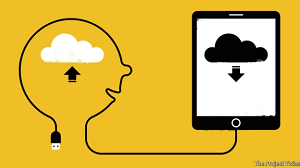Last month, The Economist ran a terrific combination feature and editorial on educational technology and how, properly deployed, it can transform the old Prussian model of schooling that most of the world has followed since the eighteenth century.
 It seems that fascination with the potential of technology to improve education has been around at least since psychologist Sidney Pressey devised a “teaching machine” in 1928 that he expected to liberate students and teachers from “educational drudgery.” It “had a paper drum displaying multiple-choice questions. Pressing the right key moved the drum on,” with candy used to incentivize kids to keep going.
It seems that fascination with the potential of technology to improve education has been around at least since psychologist Sidney Pressey devised a “teaching machine” in 1928 that he expected to liberate students and teachers from “educational drudgery.” It “had a paper drum displaying multiple-choice questions. Pressing the right key moved the drum on,” with candy used to incentivize kids to keep going.
B.F. Skinner, the behavioral psychologist famous for “Skinner boxes,” created his own version of teaching machines in the 1950’s but, after a brief fad, everyone went back to the Prussian model.
Today, despite a rough start for full-time virtual schooling, we’re pumped about the potential of technology to boost education—excited by promising models of blended learning, thrilled by the soaring example of the Khan Academy, and encouraged by the big bucks (from Zuckerberg et al.) going into the personalizing of primary-secondary education.
That’s in the United States. The Economist astutely points out that technology can be a far larger boost to education in developing countries where schools work badly or not at all and where cell phones and the internet are moving faster than sluggish ministries of education. Technology, the editors explain, can help with two important reforms. The first, which Americans generally call personalization but which they dub “bespoke education,” enables individual children to proceed through the curriculum at their own speed.
The second is “making schools more productive” by saving teachers time and boosting the efficiency of all manner of management and record-keeping tasks.
Ed-tech is not an unmixed blessing, however, and the editors go on to lay down several key precepts that are very much worth keeping in mind as we move forward.
First, “‘personalised learning’ must follow the evidence on how children learn. It must not be an excuse to revive pseudoscientific ideas such as ‘learning styles’: the discredited theory that each child has a particular way of taking in information.”
Second, don’t let technology mislead us into the “falsehood” that “children do not need a broad body of shared knowledge because they can always turn to Google. Some educationalists go further, arguing that facts get in the way of skills such as creativity and critical thinking. The opposite is true.” (Cue E.D. Hirsch.)
Third, “make sure that edtech narrows, rather than widens, inequalities in education.”
Fourth, “the potential for edtech will be realised only if teachers embrace it. They are right to ask for evidence that products work. But scepticism should not turn into Luddism.”
My own sense is that innovators, philanthropists, and reformers in American education are keenly attuned to the latter two precepts but aren’t paying close enough attention to the first pair. (That includes my pal Tom Vander Ark!) It’s not too late, however, to set matters right. If we do, we may yet manage to escape from Prussia.
— Chester E. Finn, Jr.
This first appeared on Flypaper.


